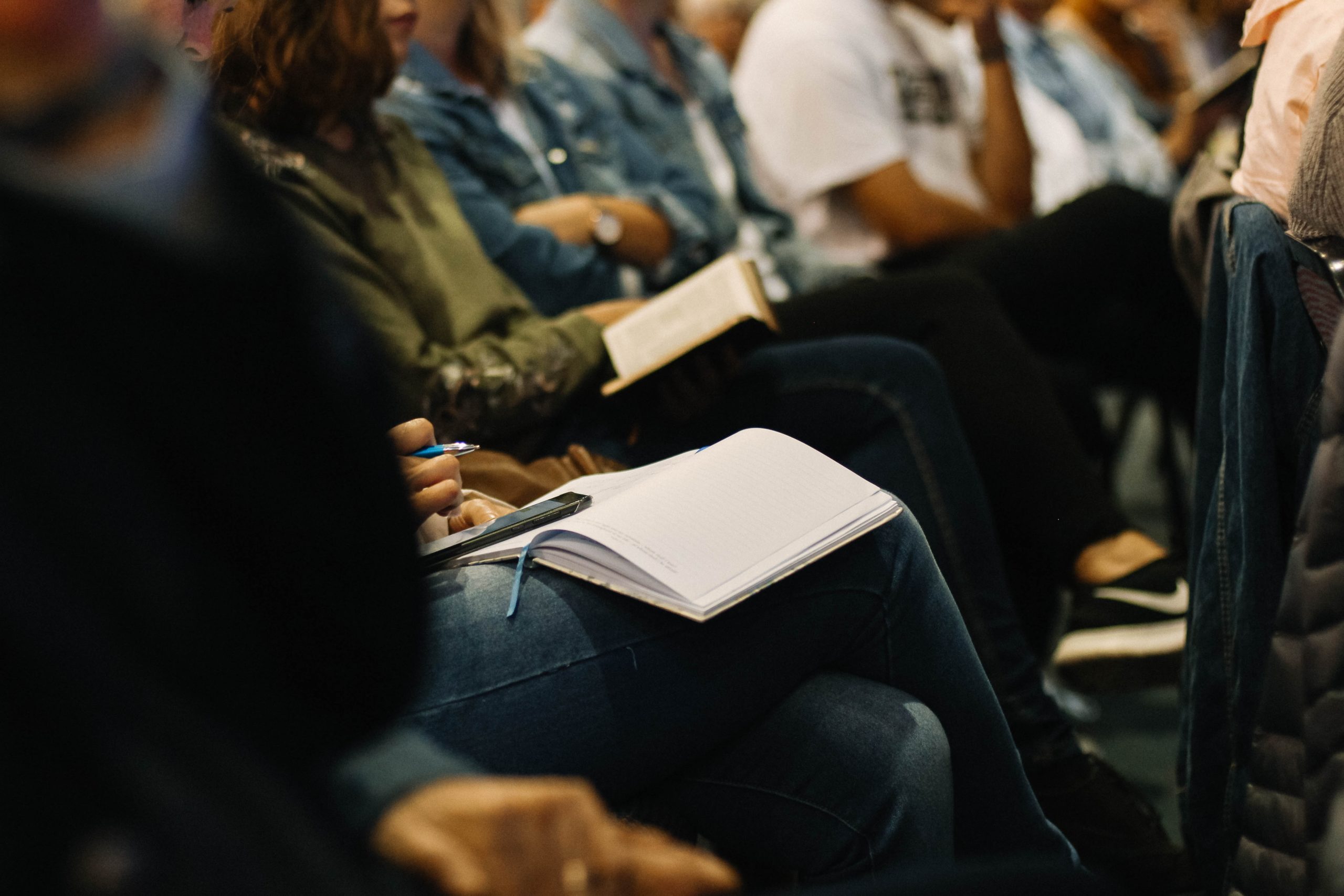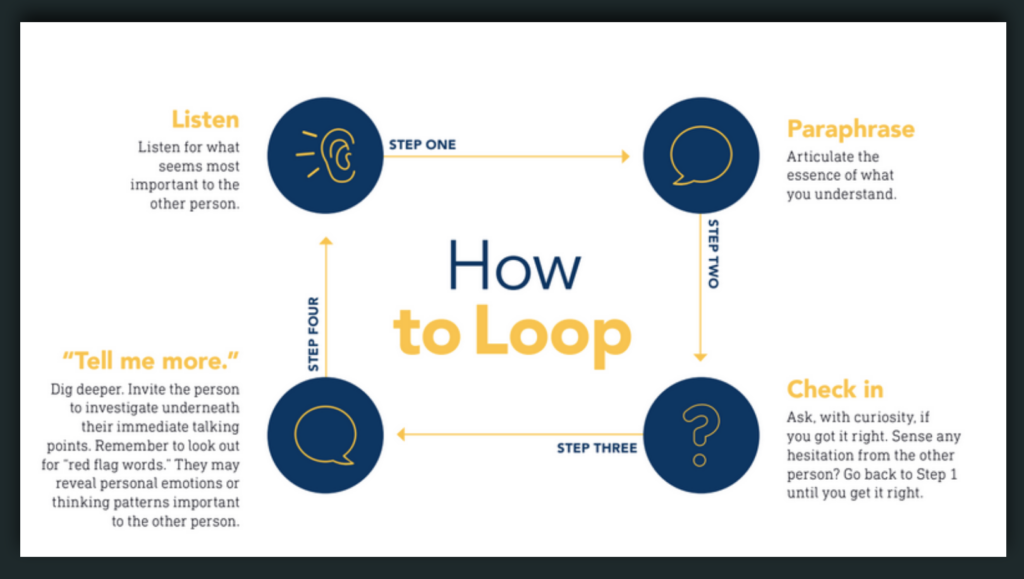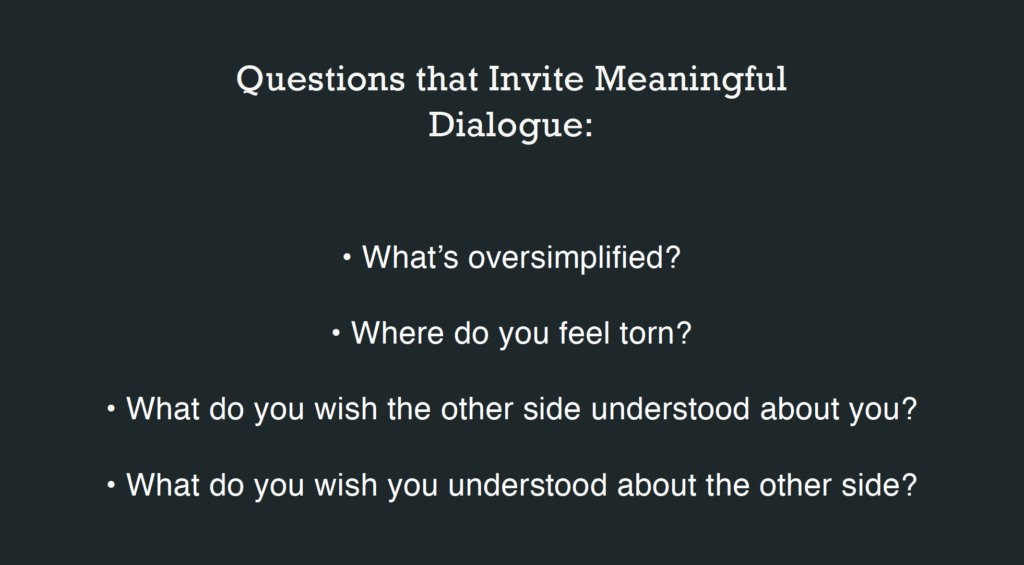Editor’s Note: The American Press Institute is helping news organizations reimagine local opinion journalism to promote healthier civic discourse and to better understand its role in news business sustainability. This essay by Hélène Biandudi Hofer, cofounder of Good Conflict, is part of a series of essays on the topic, and explores how opinion editors might create space for deeper engagement that helps residents overcome local division.
On a fall evening last year, I was brimming with excitement, anticipation, suspense, and, if I’m being honest, a trace of fear.
Good Conflict was minutes away from an experiment in collaboration with the Rochester Beacon to engage community members in dialogue on the intersection of faith and abortion. The Beacon’s editors, who were in the room with me, and I didn’t know what to expect. We were going to ask people to be curious about another person’s perspective on a contentious issue. They were going to engage without the comfort of a screen or the ability to debate.
Constructive, healthy discourse has lost its way today, dwarfed by polarization which continues to rise in our communities. Polarized views often find a home on the opinion sections of publications near and far. Typically a space for national politics and issues that a local publication might not cover, especially in the age of dwindling media sources, the opinion section has been a mainstay for decades. However, things are changing.
A couple of years ago, the New York Times decided to retire the term “Op-Ed.” While letters to the editor would still be encouraged, the publication did away with the label. For years, the page lived across the editorial page, welcoming news and views from different vantage points. In a digital world, the paper wrote, there is no “geographical ‘Op-Ed,’ just as there is no geographical ‘Ed’ for Op-Ed to be opposite to. It is a relic of an older age and an older print newspaper design.”
Opinion sections often get mixed reviews. Some readers believe that with the rise of digital media, news is often cloaked in opinion. Others see it as a platform to provide much-needed perspective in a polarized society.
These are changing and challenging times for the news media to navigate opinion while connecting with readers nationally and locally by informing them. What if we were to reframe opinion to engage communities and curate storytelling networks that bring people and communities together?
That’s what happened with the Rochester Beacon project.
Listening, learning and sharing — not debating
We partnered with the Beacon to examine whether individual beliefs and perceptions about difficult, contentious topics can be expanded through written and video journalism and moderated discussions using the Good Conflict approach.
The approach was developed by journalist, writer and conflict mediator Amanda Ripley and myself. We aim to help journalists, editors, producers and news directors adapt what they do for our current age of political polarization.
Our work is based on what researchers now know about what humans need to thrive in a diverse, highly interdependent, information-saturated and fast-changing world. It helps newsrooms effectively apply insights from neuroscience and the practices of conflict mediation, solutions journalism and social psychology to the storytelling process.
This approach fit neatly with the Beacon’s mission. The non-ideological nonprofit news platform was launched in 2018 with the mission to foster open-minded discussion of important social, economic and political issues, providing a forum for diverse voices.
After careful deliberation, we chose the topic of abortion in the religious context in the wake of the Supreme Court’s decision to overturn Roe v. Wade. It is widely known that for many who are opposed to abortion, their views are grounded in religious belief. While a number of religions and denominations are pro-choice, people’s views are expected to lie in two camps — for or against — with hardly any room for nuance and personal experiences on either side.
An element of Good Conflict’s work with the Beacon was a facilitated discussion. We invited 15 people from diverse faith backgrounds for a small-group gathering. We were elated when 14 people walked through the door, fueled by curiosity. Some were there ready to argue their point of view, others weren’t sure which way the conversation would go. There was no guest list, so people did not know who would be present.
All the necessities for a meaningful gathering were present — food, music, party favors (in the form of take-home resources) and warm and inviting hosts there to guide and support. We explained the purpose and laid some ground rules. We were not there to debate. We were there to listen, learn and share our stories — in order to join in and respond to the conversation prompt posed to the group, an individual had to repeat what they had just heard from another group member and check whether their interpretation was accurate. That’s a technique we use in Good Conflict called looping. It was developed by Gary Friedman and Jack Himmelstein of The Center for Understanding in Conflict.
After a short discussion and a quick looping demonstration, we were off to the races. One by one, each person in the room, except one, looped and bravely and vulnerably shared a personal experience that informed their view on abortion. The atmosphere shifted. Labels and initial judgments were shelved as humanity was revealed.
And guess what? Religion did not dictate every view.
People trusted the space, honored the rules and found ways to connect with each other in meaningful ways. Personal stories moved attendees and the facilitators. The understanding of how personal experiences can shape opinion left a profound impression. After the meeting, people lingered to ask: When can we do this again? What do we do next? Can we transfer this to discussions online?
A couple of months later, a Beacon editor shared an anecdote with me that demonstrates the value of this event and its potential. Two members of the group — on opposite sides of the debate — ran into each other at a community gathering. They chatted for an hour and hoped to meet again, since they had similar interests. Those individuals would readily share their experience with the Beacon for a news story later, knowing that their voices would be heard and respected, as demonstrated in the small-group discussion.
Fostering the quality of community communication
When we worked with the Laconia Daily Sun, we were able to achieve some results as well, using a similar approach with opinion section contributors. However, since that was a virtual event at the onset of the COVID-19 pandemic, technology and the power of in-person communication presented challenges. The news outlet launched an online community as a follow-up to our online gathering, called the Digital Public Square, so people could exchange ideas in real-time. While readers were engaged in the Letters section — a constant at the paper — limited online tools made it difficult for the news team to see progress online.
One thing is clear from both examples: News platforms can find other ways to connect with their communities. Too often, as “media chiefs,” we focus on the number of readers and forget about the quality of readers we could draw. By inviting community members to engage in deeper ways, they are likely to feel connected and appreciated and recommend the news outlet in their circles as a source of information and respect. It’s hard to hate someone you know. You can disagree, but hatred slows down.
Opinion can and should be more than a page in a newspaper or a comment below a story. I believe that when it comes to carefully facilitated discussion, the options are plenty by focusing on local issues and zeroing in on stories that directly affect readers and matter to them personally. Storytelling networks and events within our communities can shape and inform news stories, which then make news organizations personally relevant.
Elevating local voices and issues
As we reframe our approach to opinion, we should be cognizant of the fact that trying new things takes time and a willingness to keep innovating and perfecting tactics. I’m reminded of the Desert Sun’s experiment in California.
For a month, the publication did not run syndicated national columnists on the opinion section. There was no rhetoric on national politics. The paper focused on topics and writers from the local area and the state. It made the move to see if it would stem polarization, surveying readers before and after the project and comparing it with another local paper that did not change its content during that period.
Attitudes toward opposing parties and the comfort around members of those parties stayed flat at the Desert Sun, among readers with high levels of political knowledge and regular participants in politics. At the other publication, polarization increased.
If the media is continuously evolving when it comes to delivering the news — a swankier website or a new data visualization — it’s hard to assume that readers are unwilling to embrace new ways to engage with their trusted sources of information.
Let’s use shared storytelling in imaginative and tactical ways to dislodge the “us vs. them” narrative. Readers and viewers want to be heard. As a matter of fact, we all do. It’s storytelling that can bring us closer together. And, more often than not, opinion is deeply connected to a personal story. However, those aspects end up on cutting-room floors, and opinions, videos or words become a mix of cold facts, statistics, arguments and extreme points of view.
It’s up to us, as members of the press, to make the storytelling process meaningful and catalytic and, dare I say, sacred. We already know that stories cut through clutter and hype and have the power to engender trust and connection. “A sacred story is a window that offers perspective,” says writer and facilitator Mark Yaconelli. It’s through storytelling that we can transform fear, anger and pain — and learn more about ourselves and the world around us.
Every opinion is an untold story.
Hélène Biandudi Hofer is a broadcast journalist, documentary producer and cofounder of Good Conflict. She is also a board member of the Rochester Beacon.
Share with your network
- Read these voices on reimagining local opinion journalism
- Bring constructive conflict to local opinion journalism
- Invest in staff to grow local opinion journalism’s reach with diverse communities
- Clarify your opinion product’s mission to boost audience financial support
- How local opinion sections can transform into public forums: Insights from public deliberation
You also might be interested in:
The two organizations will provide a series of monthly webinars to local media leaders and journalists in the months leading up to the 2024 U.S. elections, and share practical resources throughout the year to support news organizations’ evolving needs around local elections and democracy.
We challenge local news organizations to smartly deploy their resources around the elections that most matter to their communities in 2024 — and also to think about how that energy builds to something more robust and sustained.
Journalism has the power to connect our communities, to bring out the best in what our society can be. Our goal is to help us all get there.





